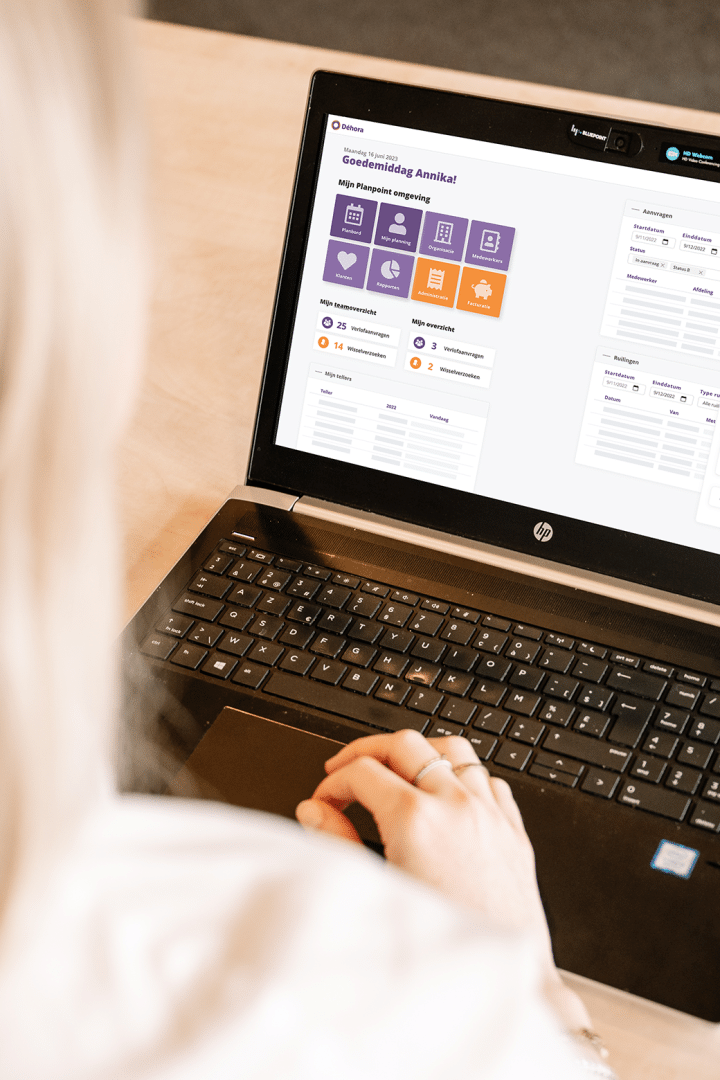
Modern planning software for family care at Welfare Association West Brabant
Discover how Welfare Association West Brabant, a Belgian network of 26 Public Social Welfare Centers (OCMWs) in the Halle-Vilvoorde region, took the step towards digital work schedules with Planpoint, and learn how this transformation directly benefits both caregivers and clients.
More efficient care through collaboration
Combining expertise and experience is a key driver of success. This is reflected in the successful collaboration between Déhora Consultancy and Welfare Association West Brabant. The result? An efficient and advanced planning solution for both family care and supplementary home care.
Regional family care and home care
Welfare Association West Brabant is a cooperative of 26 Public Social Welfare Centers (OCMWs) in the Halle-Vilvoorde region around Brussels. The members of Welfare Association West Brabant can rely on various regional services, the largest by far being the regional family care service.
Every day, more than 100 employees are on the road on behalf of 16 OCMWs, providing high-quality home care. On an annual basis, this amounts to no less than 110,000 hours of care delivered to 741 families. Today, the family care service of Welfare Association West Brabant is already the third largest public family care service in Flanders. For supplementary home care, there is also a partnership with two OCMWs, with six staff members involved.
From manual work to digital planning
Over the years, the number of care hours and employees increased significantly, but the planning system lagged behind. Regional coordinators created their own Excel overviews, which were printed, entered, and double-checked by the administration. This was time-consuming and error-prone. Every schedule change had to be communicated to colleagues by phone. At Welfare Association West Brabant, flexibility is key: due to illness, holidays, and shift swaps, work schedules are constantly in motion.
Davy Rottiers, administrative staff member at Welfare Association West Brabant, explains: “On top of that, all worked hours had to be tracked manually for invoicing and subsidies. Managing this with separate Excel files for every region was no longer sustainable. We urgently needed a modern planning solution.”
This led to a major digital transformation in workforce planning, with Déhora selected as the software partner. With Planpoint, Déhora provided not just a software solution, but also acted as a knowledge partner, helping to shape the ideal planning solution for family care. Tom Troch, home care coordinator, adds: “When selecting software, we didn’t just look at cost, but also at expertise and flexibility. Déhora offered Planpoint along with the knowledge and customer focus to address our specific challenges.”
Innovation through collaboration
What began as an idea for scheduling software evolved into a complete solution that brings together all aspects of family care: work schedules, client files, administration, time registration, and even route guidance. By adopting a co-creation model, Planpoint was developed tailor-made yet remains broadly applicable within the sector.
“Planpoint brings together all administrative, supporting, and planning processes in one platform. We now have a complete solution that integrates schedules, administration, invoicing, and even route guidance,” says Tom. “This allows us to deliver even better home care, with less paperwork and fewer error-prone processes.”
“Planpoint combines all administrative, supporting, and planning processes: work schedules, administration, meal services, time registration, invoicing, and even route guidance.”
Less administration, more valuable time
With Planpoint, staff and coordinators at Welfare Association West Brabant now always have access to up-to-date schedules and recorded hours. This significantly reduces the administrative burden and has drastically cut the use of physical documents. “Planpoint really is a complete solution that not only makes our work easier but also saves us time,” Davy says enthusiastically. “That extra time can be invested in meaningful tasks, and at the same time we save a lot of paper – good for us and for the trees!” he laughs.
Integration with Vesta and KSZ
One of the major advantages of Planpoint is its smooth integration with external systems such as Vesta and the Belgian Crossroads Bank for Social Security (KSZ). These integrations provide direct access to up-to-date client information, improving accuracy in invoicing and subsidy applications. For Welfare Association West Brabant, this means a seamless, integrated solution that streamlines both care planning and administration.
Involvement of caregivers
Planpoint also brings huge benefits for the caregivers themselves. Thanks to the web-based application, they can easily access their personal schedules, client files, and registration options via their phones. With the Employee Self Service (ESS) function, they can record expenses, report illness, and even add notes about clients. The latter is especially valuable for follow-up by family caregivers, doctors, or relatives.
“Caregivers can log observations and changes during visits – whether it’s the client’s health, behavior, or new support needs. This is incredibly useful,” Davy explains. “The mobile app is intuitive and user-friendly,” he adds. “For our caregivers, it means less paperwork and a modern, easy-to-use experience. If you can use Facebook, you can use Planpoint.”
Highlights of this collaboration
Planpoint provides Welfare Association West Brabant with a scalable solution, ready for future challenges. “Together, we built software that supports all our processes,” Tom says proudly. “It feels good to have a solution that is flexible, sustainable, and prepares us for what lies ahead.”
- More efficient planning and time savings: The planning process is now much faster thanks to digitalization and centralized data.
- Automatic communication: Staff are immediately notified of schedule changes.
- Integration with external systems: Planpoint links with Vesta and KSZ, ensuring client information is always up to date and seamlessly used for invoicing and reporting.
- User-friendly mobile access: Caregivers can view schedules and client files directly on their phones.
- Employee Self Service (ESS): Staff can submit expenses, sick leave, and notes via their phones, boosting efficiency and reducing paperwork.
- Sustainable knowledge-sharing partnership: Thanks to the co-creation model, the solution continues to evolve in line with the specific needs of the family care sector.
The collaboration with Déhora has enabled Welfare Association West Brabant to implement modern planning software that perfectly matches the complex requirements of family and home care. With its user-friendly interface, powerful integration capabilities, and flexible access, this digital transformation has proven to be a major success.
Want to know more about Planpoint?
Are you looking for a new planning software for your organization? Or do you have a specific question? Leave your details below and we’ll get back to you.

